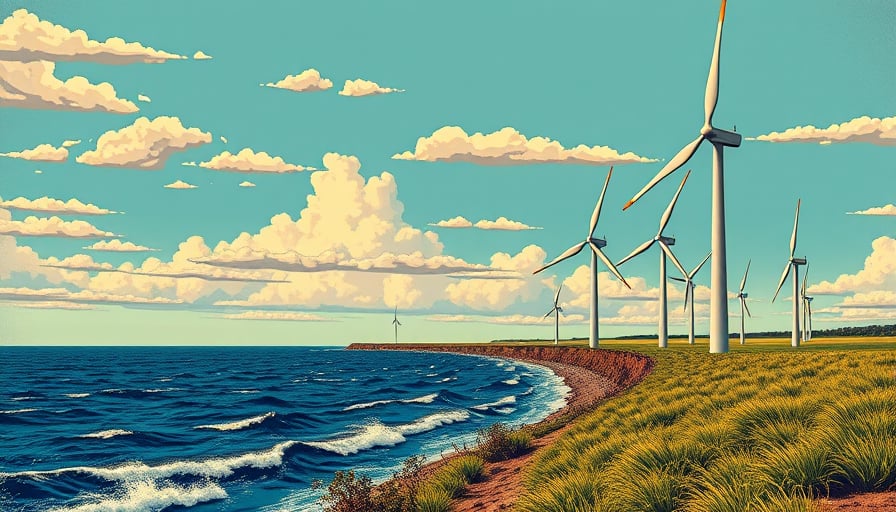Ørsted’s Third‑Quarter Loss and Strategic Measures in the Context of Offshore Wind and Grid Modernization
Ørsted disclosed a third‑quarter loss largely attributable to substantial impairment charges associated with its offshore wind portfolio. The impairment reflects revised forecasts for the company’s wind‑farm development pipeline amid lower wind speeds and a more competitive market for offshore capacity. Despite this accounting impact, operational metrics—capacity factor, production volume, and revenue per megawatt‑hour—remained robust, underscoring the resilience of Ørsted’s generation assets.
Financial Restructuring to Fortify Balance Sheet
To shore up liquidity and support its long‑term offshore strategy, Ørsted completed a sizeable rights issue, issuing new shares to existing stakeholders and a private investor group. Concurrently, the company divested a 50 % equity interest in the Hornsea 3 offshore wind farm to a strategic partner. These maneuvers released capital, reduced debt leverage, and positioned Ørsted to pursue additional projects without compromising its cost‑of‑capital targets. Analysts have noted that the timing of the rights issue and asset sale aligns with broader industry trends where operators are recalibrating asset portfolios to accommodate tighter financing environments and regulatory shifts in the European Union.
Implications for Grid Stability and Renewable Integration
Ørsted’s offshore assets feed into the North Sea interconnect and the UK’s National Grid. The integration of high‑capacity offshore wind presents several grid stability challenges:
Variable Power Injection and Frequency Control Offshore turbines exhibit rapid power output swings due to wind variability, which can perturb system frequency. Modern wind turbines now incorporate power‑curve flattening and synthetic inertia capabilities to mitigate these effects, but grid operators still require advanced forecasting and dynamic controls to maintain synchronism.
Voltage Regulation and Reactive Power Management Large offshore wind farms can generate significant reactive power deficits, especially during low wind periods when active power output drops. Ørsted’s turbine control systems now routinely deliver reactive power support, reducing the burden on substations and enhancing voltage stability across the interconnection corridor.
Grid Capacity Constraints The Hornsea 3 farm’s 1.4 GW capacity stresses existing transmission assets. Ørsted’s investment in export cable upgrades, coupled with coordinated scheduling with the UK Transmission System Operator (TSO), helps prevent bottlenecks and ensures that renewable output reaches the bulk grid efficiently.
Contingency Planning and Black Start Capability In the event of grid disturbances, offshore wind farms can contribute to black‑start operations. Ørsted’s strategic placement of its farms along key transmission corridors enables rapid restoration of supply, reinforcing overall system resilience.
Regulatory and Rate‑Structure Considerations
The European Commission’s Green Deal and the UK’s Net Zero Strategy mandate aggressive renewable integration, but they also introduce complex regulatory frameworks governing tariff design and investment returns. Key aspects include:
Feed‑in Tariffs vs. Market‑Based Mechanisms Ørsted historically benefited from the UK’s Renewable Obligation Order, but the shift to the Contracts for Difference (CfD) scheme has introduced more competitive pricing. The company’s recent investment in offshore assets aligns with CfD contracts that provide price certainty while allowing for market participation.
Grid‑Use Charges and Infrastructure Fees The National Grid levies charges for the use of its transmission assets. Ørsted’s recent upgrades to export cables have reduced these fees by enhancing transmission efficiency. Additionally, the company’s participation in the “Green Deal” financing framework could unlock lower-cost capital for future projects.
Rate‑Setting and Consumer Impact The cost of offshore wind, after accounting for impairment, is reflected in the consumer tariff structure. However, the marginal cost of wind is effectively zero; thus, the financial losses are largely a bookkeeping artifact rather than a direct price increase. The long‑term benefit lies in reduced reliance on fossil fuels, lowering overall system costs and shielding consumers from volatile fuel markets.
Economic Impact of Utility Modernization
Ørsted’s capital‑raising and asset‑sale activities illustrate a broader trend of utility modernization:
Capital Efficiency By divesting a portion of the Hornsea 3 stake, Ørsted can reallocate capital toward new projects with higher risk‑adjusted returns, improving portfolio diversification.
Risk Management The rights issue expands equity base, lowering debt‑to‑equity ratios and enhancing creditworthiness. A stronger balance sheet attracts institutional investors seeking long‑term, low‑volatility returns, which can further support renewable expansion.
Technology Adoption Investments in advanced turbine control, battery storage integration, and smart grid analytics are capital‑intensive but deliver grid stability dividends. Ørsted’s focus on these areas positions it to meet the upcoming demand for flexible resources that balance intermittency.
Consumer Cost Trajectory While the immediate impact of impairment charges may not translate into higher tariffs, the long‑term effects of increased renewable penetration—such as lower wholesale energy prices and reduced fuel subsidies—are projected to lower consumer costs. Moreover, grid upgrades reduce transmission losses, improving overall system efficiency.
Engineering Insights into Power System Dynamics
The successful integration of offshore wind hinges on understanding complex power system dynamics:
Dynamic Stability Analysis Engineers employ small‑signal stability studies to ensure that the turbine’s governor and power‑controller loops remain responsive under varying load conditions. Ørsted’s turbines are rated for a 3‑p.u. droop response, providing rapid corrective actions to maintain frequency.
Power Flow Optimization Advanced algorithms such as optimal power flow (OPF) models are used to schedule offshore wind output while respecting thermal limits of the interconnection cables. This approach minimizes congestion and enhances voltage profiles across the grid.
Cyber‑Physical Security The digital control systems that manage offshore turbines are vulnerable to cyber‑attacks. Ørsted has implemented redundant communication links and intrusion detection systems to safeguard grid operations, ensuring that physical and cyber‑domains remain synchronized.
Conclusion
Ørsted’s recent third‑quarter loss, while noteworthy, reflects broader industry dynamics where impairment charges are part of the financial reconciliation of high‑valuation renewable projects. The company’s strategic rights issue and partial divestiture of Hornsea 3 have reinforced its balance sheet, enabling continued investment in offshore wind while addressing grid stability and regulatory challenges. Through targeted infrastructure upgrades and sophisticated control strategies, Ørsted is positioned to contribute to a resilient, low‑carbon power system that balances economic viability with consumer affordability.
